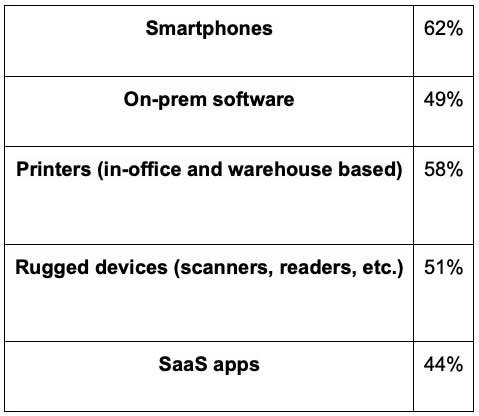Report finds nearly half of U.S. businesses increased number of devices to manage distributed workforce.
NEW YORK, NY – The distributed workforce now exists beyond the rise of hybrid, flexible or remote working environments and it is having a significant impact on business operations across various industries. New global research from SOTI, “When Work is Anywhere: Managing Technology’s Role in the Distributed Workforce,” found 48% of U.S. companies have increased the number of devices deployed across operations in the last 12 months. This creates more data and complexity for IT teams, calling for more visibility and secure management of devices across operations.
With the distributed workforce here to stay, the report discusses how organizations across various industries are increasing their investment in new technology and devices as the workforce and infrastructure becomes more widespread.
Advancements in the Internet of Things (IoT), e-commerce, real-time supply chain visibility and critical communications across a global landscape have resulted in a seismic shift to more distributed operations. As a result, nearly half of U.S. organizations (46%) have seen an increase in the mix of device types (including smartphones, barcode scanners, rugged handsets, mobile computers, etc.).
The report also found that with the increased adoption of new technologies, U.S. businesses have decided to manage the majority of its devices in-house including:

“Ensuring increased productivity of a distributed workforce is one part of the equation,” said Shash Anand, SVP of Product Strategy at SOTI. “Today, businesses have access to technology to effectively manage the supply chain and track and control device usage in the field. It is a matter of investing in new ways to oversee and analyze the subsequent growth in technology and data over time.”
With increased enterprise use of devices, more data is being collected, processed and stored than ever before, fostering the need for data management security and compliance. The report found that over the last year, 40% of respondents cited the need for better access control to protect the IT network, while 34% increased their spend on mobile technology security.
“With distributed operations there is a higher probability of a more fragmented global tech footprint due to the complex dynamic of devices and data,” adds Anand. “There needs to be seamless visibility and agility to monitor the health and use of these devices, with issues being fixed quickly once they arise. Without it, organizations will simply not yield the productivity and efficiency gains from their investments and leave themselves open to even more risks.”
The influx of the distributed workforce demonstrated the need for technology to be leveraged in two forms – first in the capabilities of physical devices to aid in day-to-day productivity, and second in effectively managing all devices in an increasingly dispersed operational environment.
Even though digital workflows are becoming more commonplace, the report found nearly 70% of U.S. organizations were still using manual processes to manage their workflows. Reliance on manual processes continues to play a significant role, suggesting that organizations still have a way to go to truly manage a new operational infrastructure. In fact, in the past year nearly all manual workflows have been done on paper (46%) and email (55%).
Unfortunately, the continued use of outdated, paper-based processes is alarming as this means sensitive data such as patient and customers’ payment information is unsecured, leaving personal data at the risk of being breached.
“It’s no secret that organizations have struggled to cope with the speed of change amid accelerated digital transformations. However, businesses must understand that discarding outdated legacy processes and software will ensure that data and devices are monitored, supported and kept secure,” concludes Anand. “By investing in robust management of devices, IT teams can improve operations, prevent attacks, enhance workforce productivity and ensure ongoing business health and success in an increasingly dispersed operational environment.”
SOTI’s report “When Work is Anywhere: Managing Technology’s Role in the Distributed Workforce” can be downloaded here.
Report Methodology
SOTI’s research was conducted online between February 4 and February 17, 2023, via interviews with 2,500 people aged 18 and over. The interviews were conducted via online methods, with IT professionals working in companies comprising of more than 50 employees globally. The 2,500 interviews were split across eight markets. These were: U.S. (500), Canada (250), Mexico (250), UK (500), Germany (250), France (250), Sweden (250) and Australia (250). In addition to seeking to present global, overarching trends, the results were broken down by these individual markets while also analyzing data from different company sizes and sectors.
About SOTI
SOTI is the world’s most trusted provider of mobile and IoT management solutions, with more than 17,000 enterprise customers and millions of devices managed worldwide. SOTI’s innovative portfolio of solutions and services provides the tools organizations need to truly mobilize their operations and optimize their mobility investments. SOTI extends secure mobility management to provide an integrated solution to manage and secure all mobile devices and connected peripherals in an organization. For more information, visit soti.net.
In this episode, I sat down with Beejan Giga, Director | Partner and Caleb Emerson, Senior Results Manager at Carpedia International. We discussed the insights behind their recent Industry Today article, “Thinking Three Moves Ahead” and together we explored how manufacturers can plan more strategically, align with their suppliers, and build the operational discipline needed to support intentional, sustainable growth. It was a conversation packed with practical perspectives on navigating a fast-changing industry landscape.